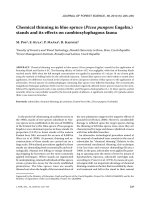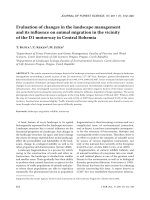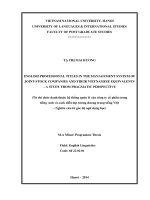FINANCIAL MANAGEMENT SYSTEM OF VIETNAM POSTS AND TELECOMMUNICATIONS GROUP AND ITS EFFECTS ON FINANCIAL EFFICIENCY OF THE COMPANY
Bạn đang xem bản rút gọn của tài liệu. Xem và tải ngay bản đầy đủ của tài liệu tại đây (551.99 KB, 117 trang )
i
THAI NGUYEN UNIVERSITY SOUTHERN LUZON STATE UNIVERSITY
Socialist Republic of Viet Nam Republic of Philippines
TO THI NGOC LAN
(ENGLISH NAME: JENNY)
FINANCIAL MANAGEMENT SYSTEM OF VIETNAM POSTS AND
TELECOMMUNICATIONS GROUP AND ITS EFFECTS ON FINANCIAL
EFFICIENCY OF THE COMPANY
DOCTORAL DISSERTATION
AUGUST, 2013
ii
THAI NGUYEN UNIVERSITY SOUTHERN LUZON STATE UNIVERSITY
Socialist Republic of Viet Nam Republic of Philippines
TO THI NGOC LAN
(ENGLISH NAME: JENNY)
FINANCIAL MANAGEMENT SYSTEM OF VIETNAM POSTS AND
TELECOMMUNICATIONS GROUP AND ITS EFFECTS ON FINANCIAL
EFFICIENCY OF THE COMPANY
DOCTORAL DISSERTATION
ADVISER: DR. JOANNA PAULA A. ELLAGA
AUGUST, 2013
iii
ACKNOWLEDGMENT
I would like to express my gratitude to Dr. Joanna Paula A. Ellaga and Dr.
Ooi Pit Tatt for being outstanding advisors and excellent professors. Their constant
encouragement, support, and invaluable suggestions made this work successful. They
have been everything that one could want in an advisor. I would like to thank them for
providing me ideas on the research methodology and valuable insights on financial
management system.
I am deeply indebted to Dr. Nguyen Thanh Hai and Ms. Trinh Thi Hieu -
International Training Center, Thai Nguyen University of the Socialist Republic of
Vietnam, for their enormous pursuit to provide the Vietnamese people an opportunity
to grow through education. Aslo, I would like to thank all the lecturers of DBA1
course for helping me to complete this dissertation which I have been their student for
three years.
I would like to acknowledge my best friends in the DBA 1 class for reviewing
my dissertation and providing valuable feedback. I am grateful to Mr. Ngo Anh
Cuong and Mr. Nguyen Duy Phuong for their help and valuable advice, and for
being great friends throughout my program stint.
I am deeply and forever indebted to my family for their love, support, and
encouragement throughout my entire life. I would like to thank my husband, Nguyen
Trung Kien, who has provided a tremendous amount of love and support throughout
this study. On a final note with love are for my five-year old son!
iv
DEED OF DECLARATION
I, To Thi Ngoc Lan (English name: Jenny), hereby submit my dissertation for
oral examination, entitled “FINANCIAL MANAGEMENT SYSTEM OF VIETNAM
POSTS AND TELECOMMUNICATION GROUP AND ITS EFFECTS ON
FINANCIAL EFFICIENCY OF THE COMPANY”, truthfully declare that the said
paper is a product of my original research investigation.
Signed this …………………….2013 at Thai Nguyen University
TO THI NGOC LAN
DBA Candidate
v
TABLE OF CONTENTS
CHAPTER I: 1
INTRODUCTION 1
1.1. Statement of the objectives 3
1.2. Significance of the Study 4
1.3. Scope and limitation of the Study 5
1.4. Definition of terms 6
CHAPTER II: 9
RELATED LITERATURE 9
2.1. Review of related studies 9
2.1.1. Foreign studies 9
2.1.2. Local studies 10
2.2. Theoretical and conceptual framework 12
2.2.1. Enterprise finance 12
2.2.2. Financial management system 16
2.2.3. Financial efficiency 23
2.3. Research Paradigm 24
CHAPTER III: 28
METHODOLOGY 28
3.1. Research Design 28
3.2. Time and Place of Study 28
3.3. Data collection method 28
3.4. Population, Sample and sampling technique 29
3.5. Research instrument 29
3.6. Data gathering procedure 30
vi
3.7. Data processing method 30
3.8. Statistical treatment 31
CHAPTER IV: 33
PRESENTATION, ANALYSIS AND INTERPRETATION OF DATA 33
4.1. Profile of VNPT 33
4.1.1. Type of company 33
4.1.2. Size of company 34
4.2. Current status of financial management system of VNPT from 2010 to 2012
37
4.2.1. Capital mobilization in VNPT 37
4.2.2. Capital management and use in VNPT 47
4.2.3. Asset management in VNPT 59
4.2.4. Management of revenues, expenses and profit distribution in VNPT 71
4.3. Effects of financial management system on financial efficiency of the VNPT.
80
4.3.1. Assess the financial efficiency of VNPT 80
4.3.2. Effects of the financial management system to the financial efficiency of
VNPT 81
4.4. Problem encountered by financial management system of VNPT 82
CHAPTER V: 83
CONCLUSIONS AND RECOMMENDATIONS 83
5.1. Summary of the findings 83
5.2. Conclusions 87
5.3. Recommendations 88
vii
ABSTRACT
In the background of deeper and wider regional and international economic
integration, enterprises have to face with more formidable competition from big
multinational economic organizations in the world. In order to adapt to that situation,
meeting to demands for economic development and market expansion out of boundary
of countries, many countries are incessantly increase scales of businesses, establishing
and developing economic groups. Vietnamese enterprises are not out of that trend.
The establishment and development of Vietnamese economic groups both
ensure the suitability to the development tendency of global economy and exploit
inherent competitive advantages of the country, speeding economic growth of the
country. In order to ensure the high efficiency of those economic groups and State
owned enterprises, it is necessary to improve efficiency of financial management
system of economic groups. Although this system has taken much progress which has
some certain effects on raising financial efficiency of the economic groups, many
troubles and constraints still exist; for example, Financial management policies and
measures of the groups are collectivistic, not closing to the actual situation of each
State owned group, which has no small constraint on the financial effectiveness of
economic groups in VietNam.
To contribute to the enhancement of financial efficiency of economic groups in
VietNam in the new situation, it is compulsory to research, innovate financial
management system of economic groups.
In expectation of contributing some ideas about perfecting financial
management system of State owned economic groups, I, the author would like to
choose the subject:
viii
“FINANCIAL MANAGEMENT SYSTEM OF VIETNAM POSTS AND
TELECOMMUNICATIONS GROUP (VNPT) AND ITS EFFECTS ON
FINANCIAL EFFICIENCY OF THE COMPANY” for this dissertation.
With such an approach to issues, the main objectives of dissertation is study
the current status of system financial management of VNPT and its effect on financial
efficiency of company. The specific objectives of this study are: (1) To identify the
profile of the company in terms of the following: Type of the company and Size of the
company; (2) To determine the current status of financial management system of
VNPT in terms of the following: Capital mobilization, Capital management and use,
Asset management, Revenue, expense and profit distribution management; (3) To
assess the financial efficiency of VNPT in terms of the following financial ratios: the
asset turnover ratio and the debtor days ratio; (4) To determine the effects of the
financial management system to the financial efficiency of VNPT; (5) To identify the
problems encountered in carrying out the financial management system of VNPT; (6)
To propose actions that will respond to the problems encountered in carrying out the
financial management system of VNPT.
In order to obtain main objectives of study, the researcher used the descriptive
method to get data which includes: Primary data was collected by sending
questionnaires to 169 respondents (CFO of VNPT, director of financial department of
VNPT, deputy director of financial department of VNPT, CFO of VNPT’s
subsidiaries) working in VNPT and its subsidiaries and secondary data: From the
annual financial reports of VNPT from 2010 to 2012. For assessing the current status
of VNPT’s financial management system, the dissertation focuses on studying the
profile and the formation and development process of VNPT as well as VNPT’s
regulations on capital mobilization, management and use of capital and assets,
ix
management of revenues, expenses and profit distribution, thereby assessing financial
management system and its effects on VNPT’s financial efficiency from 2010 to
2012. All this proves that the financial management system of VNPT effects
positively to financial efficiency of the Group.
x
LIST OF TABLES
Table 1. Distribution of the respondents 29
Table 2. Verbal interpretation 30
Table 3. The autonomic level of capital mobilization in VNPT 40
Table 4. The safe level in mobilizing capital of VNPT 41
Table 5. Assets and equity of VNPT from 2010 to 2012 42
Table 6. The autonomic level in mobilizing capital of the VNPT’s subsidiaries 43
Table 7. Clarity and fulfilment in harmonizing capital mechanism of VNPT 44
Table 8. Reasonable level regulated the loan limit at the rate payable on capital not
exceeding 3 times: 45
Table 9. The level of autonomy and self-responsibility at VNPT in using and
managing capital: 52
Table 10. Level of capital preserve in VNPT 53
Table 11. The level of responsibility in the management and use of the owner’s
capital of VNPT 55
Table 12. The effectiveness of investment outsite the sector VNPT 56
Table 13. The transparency of ownership and the right of using assets in VNPT 67
Table 14. The level of conservation of the assets in VNPT 69
Table 15. The level of efficiency in the use of assets in VNPT 70
Table 16. The level of losses and wastage in the use of assets in VNPT 71
Table 17. The clarity and transparency in managing revenues, expenses, and profit
distribution in VNPT 75
Table 18. The Level in harmonizing between the interests of the state, corporations
and employees in managing revenues, expenses and profits distribution in VNPT 76
xi
Table 19. Revenue of VNPT from 2010 to 2012 77
Table 20. The clarity of the regulations on the distribution of profits which
subsidiaries must contribute to VNPT group 78
Table 21. Profits of VNPT from 2010 to 2012 79
Table 22. The asset turnover ratio of VNPT from 2010 to 2012 80
Table 23. The debtor days ratio of VNPT from 2010 to 2012 81
Table 22. The asset turnover ratio of VNPT from 2010 to 2012 86
Table 23. The debtor days ratio of VNPT from 2010 to 2012 86
xii
LIST OF CHARTS
Chart 1. The autonomic level of capital mobilization in VNPT 40
Chart 2. The safe level in mobilizing capital of VNPT 41
Chart 3. The autonomic level in mobilizing capital of the VNPT’s subsidiaries 43
Chart 4. Clarity and fulfilment in harmonizing capital mechanism of VNPT 44
Chart 5. Reasonable level regulated the loan limit at the rate payable on capital not
exceeding 3 times: 46
Chart 6. The level of autonomy and self-responsibility at VNPT in using and
managing capital: 52
Chart 7. Level of capital preserve in VNPT 54
Chart 8. The level of responsibility in the management and use of the owner’s capital
of VNPT 55
Chart 9. The effectiveness of investment outsite the sector VNPT 57
Chart 10. The transparency of ownership and the right of using assets in VNPT 68
Chart 11. The level of conservation of the assets in VNPT 69
Chart 12. The level of efficiency in the use of assets in VNPT 70
Chart 13. The level of losses and wastage in the use of assets in VNPT 71
Chart 14. The clarity and transparency in managing revenues, expenses, and profit
distribution in VNPT 76
Chart 15. The Level in harmonizing between the interests of the state, corporations
and employees in managing revenues, expenses and profits distribution 77
Chart 16. The clarity of the regulations on the distribution of profits which
subsidiaries must contribute to VNPT group 79
xiii
LIST OF FIGURES
Figure 1. Research Paradigm 25
xiv
LIST OF ABBREVIATIONS
CEO
Chief Executive Officer
CFO
Chief Financial Officer
EGs
Economic Groups
FMS
Financial Management System
SEG
State owed Economic Group
VNPT
Vietnam Posts and Telecommunications Group
xv
Thai Nguyen University
Socialist Republic of Vietnam
Southern Luzon STATE University
Republic of Philippines
Date, July 28, 2013
APPROVAL SHEET
This dissertation, entitled, “FINANCIAL MANAGEMENT SYSTEM OF
VIETNAM POSTS AND TELECOMMUNICATIONS GROUP (VNPT) AND
ITS EFFECTS ON FINANCIAL EFFICIENCY OF THE COMPANY” prepared
and submitted by To Thi Ngoc Lan (Jenny) in partial fulfillment of the requirements
for the degree of Doctor in Business Administration, has been examined and
recommended for acceptance and approval for FINAL ORAL EXAMINATION.
Dr. JOANNA PAULA A. ELLAGA
Adviser
Signature
1
CHAPTER I:
INTRODUCTION
There are many studies about financial management system in economic
groups under the eyes of theory, situation evaluation as well as summary of
experience in the country and foreign countries. Followings are typical ones:
Firstly, the study, which was published into book, has title:
“Business Groups and financial management system in Business Groups”
published in 2003, by author Pham Quang Trung.
This study shows many basic theoretical matters about financial management
system in economic groups, State owned enterprises as well as descriptions,
summaries, analysis of overall picture of actual situation of applying financial
management system in economic groups, State owned enterprises in Vietnam in the
first period when economic groups, State owned enterprises started to go into
operation.
Nowadays, with profound changes in economic groups, State owned
enterprises under the changes of State’s policies as well as influences of economic
integration on economic groups, the value of those analysis and evaluation may not
keep intact and need to be updated.
Secondly, the study under form of textbook has title “Financial management of
modern enterprises” published in 2009, author Duong Huu Hanh. This study, although
not directly mentioning words “financial management system in economic groups”,
has contents of financial management in modern enterprises under the view of
financial management of enterprises. However, this is study compiled on the
background of studies of American and Australian professors, having color of a
2
textbook, so being more theoretical.
Thirdly, the study “Establishment and management of business Groups in
VietNam” in 1996 and the author Nguyen Dinh Phan. In this study, the author has
written few pages of financial management in business groups; however, to some
extent, the content about this issue is limit and suggestive. From that time, the
operation of the State owned enterprises in VietNam has had many alterations, so does
the financial management system.
The issue of financial management system in the economic groups gets the
attention of not only scholars in the country but also many foreign economists. For
example, Eugene F.Brigham, a German researcher, in his book "Fundamentals of
Financial Management" in 2009 also refers to problems in the financial management
of corporations in terms of general theoretical angles about concepts, characteristics,
connotation and methods of management.
Generally, about financial management system in the economic groups in
Vietnam, there are some works under the form of books which mention different
angles, but all were released from the 2000 onwards. Nowadays under the impact of
regional and international economic integration, and the management of the State for
State economic groups inevitably arises many new issues in the financial management
system of economic groups in VietNam.
Beside that, in recent years, Vietnam economy has gone through a very
difficult period. High inflation and interest rates coupled with global economic
financial crisis and public debt crisis of the European countries have a huge impact on
the business situation of economic groups in Vietnam.
In this economic setting, economic groups that want a firm stand in the marketplace
need to be flexible and ever-innovative. Innovative financial management system is
3
one of the issues of primary concern that directly affects the survival of many
economic groups in Vietnam.
In expectation of contributing some ideas about perfecting financial
management system of State owned economic groups, I would like to conduct this
study.
1.1. Statement of the objectives
This study intended to analysis of financial management system of VNPT and
its effects on financial efficiency of the Group. Specifically, the specific objectives of
this study are:
1. To identify the profile of the company in terms of the following:
1.1. Type of the company
1.2. Size of the company
2. To determine the current status of financial management system of VNPT
in terms of the following:
2.1. Capital mobilization (focus on financing activities)
2.2. Capital management and use (focus on investment activities)
2.3. Asset management
2.4. Management of revenue, expense and profit distribution
3. To assess the financial efficiency of VNPT in terms of the following
financial ratios: the asset turnover ratio and the debtor days ratio.
4. To determine the effects of the financial management system to the
financial efficiency of VNPT.
5. To identify the problems encountered in carrying out the financial
management system of VNPT.
4
6. To propose actions that will respond to the problems encountered in
carrying out the financial management system of VNPT.
1.2. Significance of the Study
Analysis of financial management system is very important in providing
information for those benefits related to business activities, helping the readers is able
to predict its financial situation in the future as well as risk assessment, quality of
business operations, from which to make financial decisions, decide the most
appropriate management. This research will be beneficial for the following:
Investors take an interest in information about the financial efficiency of
VNPT. On the one hand, they want to obtain the adequate amount of information
needed for decision-making about investments in the Group. The main attention is
paid to the degree of the risk and return on capital invested. On the other hand, owners
and investors want to make sure whether invested resources are properly evaluated
and optimized.
Managers need to know about financial management for current and long-
term decisionmaking. Continuous knowledge of VNPT performance allows managers
to make right decisions on gaining of financial resources, on determination of
the optimum financial structure, on allocation of free finances, on distribution
of profits, and on allocation of trade credits. The knowledge of financial
management is necessary for both the past and forecasting of future development.
Managers make several proposals for policy makers as well as managers of VNPT
about the improvement of the financial management system to enhance the financial
efficiency in the new context.
5
Employees are naturally interested in prosperity, economic and financial
stability of VNPT. It is concerned with job security, possibilities in wage and social
policy, or other benefits provided by the employer.
For researcher, provide theoretical knowledge of the financial management
system of economic groups in general and VNPT in particular. This study has
contributed to the enhancement of financial efficiency and has given some ideas about
perfecting financial management system of State owned economic groups in VietNam
in the new situation.
1.3. Scope and limitation of the Study
The studying scope of the dissertation is although based on the theoretical
perspective of the financial management system of the State economic corporations in
general, when studying the current status of the financial management system in the
state economic groups in VietNam, the author focuses the study on VNPT.
The study of current status of financial management system in VNPT is
performed from 2010 to 2012.
In my case, Financial efficiency, viewed as dependent variables.
Accounting information system practices; Financial reporting and analysis
practices; Capital structure management practices; Capital mobilization practices;
Capital management and use practices; Asset management practices; Revenue,
expense and profit distribution management practices, viewed as independent
variables.
But time and my ability is limited, I will focus on: Capital mobilization
practices; Capital management and use practices; Asset management practices;
Revenue, expense and profit distribution management practices, viewed as
independent variables.
6
1.4. Definition of terms
A parent company is a company that controls other companies by owning an
influential amount of voting stock or control. Parent companies will typically be larger
firms that exhibit control over one or more small subsidiaries in either the same
industry or other industries.
Capital invested by the State in the Parent Company are the capital directly
taken from the state budget for the parent company in the operation (if any); capital
received by the State from other resources as decisions of the competent authorities;
additional capital from profit after tax; value of land using rights and other capitals
considered as State capital in accordance with the State law.
Capital preservation in the parent company means that capital is kept intact
and not be deficit during the operation of the parent company.
Capital raised by the parent company is the capital that the parent company
raises under the forms of bonds, bills of credit, debentures; loans from organizations
and individuals in the country and foreign countries; and other capital mobilizing
forms that are not prohibited by law.
Capital's parent company invested in other enterprises is capital of the
parent company invested in other businesses apart from the parent company.
Dependent accounting units are units accounted dependently from the parent
company.
Dividends are payments made by a corporation to its shareholder members. It
is the portion of corporate profits paid out to stockholders. When a corporation earns a
profit or surplus, that money can be put to two uses: it can either be re-invested in the
business (called retained earnings), or it can be distributed to shareholders. There are
7
two ways to distribute cash to shareholders: share repurchases or dividends. Many
corporations retain a portion of their earnings and pay the remainder as a dividend.
Equity is the residual claim or interest of the most junior class of investors in
assets, after all liabilities are paid. If liability exceeds assets, negative equity exists. In
an accounting context, Shareholders' equity (or stockholders' equity, shareholders'
funds, shareholders' capital or similar terms) represents the remaining interest in
assets of a company, spread among individual shareholders of common or preferred
stock.
Financial efficiency reflects the relationship between the economic benefits
of Capital mobilization; Capital management and use; Asset management; Revenue,
expense and profit distribution management that businesses receive with a cost that
businesses have to spend to obtain economic benefits.
Financial management system is the methodology that an organization uses
to oversee and govern its Capital mobilization; Capital management and use; Asset
management; Revenue, expense and profit distribution management with the
objectives of maximizing profits and ensuring sustainability.
Governing shares and contributing capital are shares or contributing capital
that company occupies over 50% of the charter capital.
Non-productive units are units providing research, training, healthcare
services under the management of the Parent Company.
Owner is the State owner of the parent company. The Government unifies the
implementation of rights and obligations of the owner to the parent company. The
Prime Minister directly performs or authorizes Ministries, the ministerial-level
agencies, the agencies attached to the Government to implement a certain number of
rights and obligations of the owner to the parent company in accordance with the law.
8
Profit is the difference between the purchase and the component costs of
delivered goods and/or services and any operating or other expenses.
Revenue is income that a company receives from its normal business
activities, usually from the sale of goods and services to customers. In many
countries, revenue is referred to as turnover.
Representative is the person which is appointed by the Board of Directors to
represent for capital or to candidate or participate in the Management Board and
management in companies which have capital of the parent company.
Subsidiary is an independent accounting firm of which charter capital is held
100% by the parent company and being a company that the parent company holds
dominant shares, capital or controlling shareholder through rights of directly or
indirectly appointing a majority or all of the Board members, the general director or
manager of that firm or deciding to modify or supplement the charter of that firm.
9
CHAPTER II:
RELATED LITERATURE
This chapter presents the literature related to this Study. It includes related
studies and definition of finance, contents of financial management system, factors
influencing financial management system, criteria for financial efficiency evaluation
of financial management system and definition of financial efficency.
2.1. Review of related studies
2.1.1. Foreign studies
The Frank J. Fabozzi & Pamela P. Peterson, “Financial Management and
Analysis”, 2003
Financial Management and Analysis is presented in seven parts. The first two
parts (Parts One and Two) cover the basics, including the objective of financial
management, valuation principles, and the relation between risk and return. Financial
decision-making is covered in Parts Three, Four, and Five where the authors present
long-term investment management (commonly referred to as capital budgeting), the
management of long-term sources of funds, and working capital management. Part Six
covers financial statement analysis which includes financial ratio analysis, earnings
analysis, and cash flow analysis. The last part (Part Seven) covers several specialized
topics: international financial management, borrowing via structured financial
transactions (i.e., asset securitization), project financing, equipment leasing, and
financial planning and strategy.
Authur J. Keown, John D. Martin, J. William Petty, David F. Scott, Jr
“Financial management princiles and Application”, 2005
With its exciting introduction of the Harly - Davidson focus company theme,
10
this book continues to provide a solid, enduring foundation of the tools of modern
theory while at the same time developing the logic behind their use. The "10
principles of finance" (formerly "Axioms") provide the framework, or "the big
picture" of the finance, which ties the major concept of the book together. A six part
organization covers the scope and environment of financial management, valuation of
financial assets, investment in long term assets, capital structure and dividend policy,
working capital management and special topics in finance. For an enduring
understanding of the basic tools and fundamental principles upon which finance is
based.
2.1.2. Local studies
Pham Quang Trung, “Business Groups and financial management system
in Business Groups”, 2003.
This study shows many basic theoretical matters about financial management
system in economic groups, State owned enterprises as well as descriptions,
summaries, analysis of overall picture of actual situation of applying financial
management system in economic groups, State owned enterprises in Vietnam in the
first period when economic groups, State owned enterprises started to go into
operation.
Nowadays, with profound changes in economic groups, State owned
enterprises under the changes of State’s policies as well as influences of economic
integration on economic groups, the value of those analysis and evaluation may not
keep intact and need to be updated.
Duong Huu Hanh , “Financial management of modern enterprises”, 2009.
This study, although not directly mentioning words “financial management
system in economic groups”, has contents of financial management in modern









